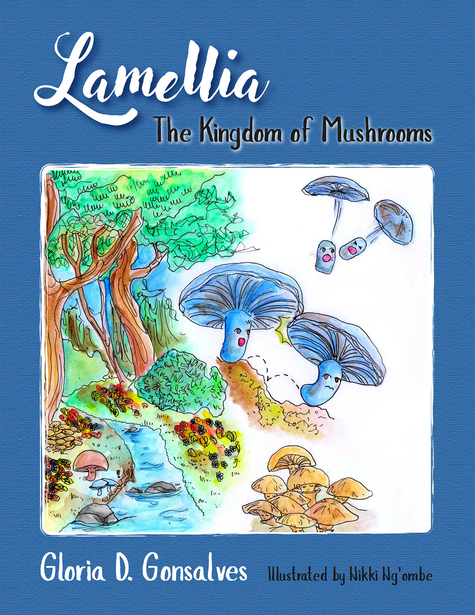★★★½ 
Lamellia: The Kingdom of Mushrooms by Gloria D. Gonsalves is a whimsical and yet a rather unusual book following a society of mushrooms and its fungal king called Polipoli. They’re an advanced society with warring factions who are all based on actual mushroom species that grow in the world today.
One day while venturing off in the forest, a group of Lamellians discover a human baby all by herself. They decide to adopt the baby and use their mushroom abilities to care for her – such as milk from the Indigo mushroom and a soft bed for her to sleep in. With colorful and spirited illustrations by Nikki Ngombe, Lamellia is a unique and creative book for children with an enchanting premise. Kids will love the unusual drawing style that may inspire some imaginative artwork from young readers studying the images.
The trouble with the book is that it ends just as it’s getting started. On Gonzalves’ website, she asks the question, “Do you know what happens when mushrooms raise a human child?” It’s an intriguing idea, but the book actually comes to a close fairly abruptly after the baby is brought into the kingdom. This ties together with the “scarier” aspects of the book, where the King determines, “This baby has been abandoned by its family,” yet there’s no real sense this is true. In which case, what’s happened is that the mushrooms have seemingly kidnapped a baby – who may be enjoying herself, but even kids may be a bit disconcerted that the baby’s been snatched away from her parents without finding out for sure this really happened, and why. After all, children can easily relate to characters in a book all too easily.
Furthermore, it’s not really clear why the mushrooms, with their very sophisticated society, should be so in the dark about humans – whom they have experience with frequently, as humans pick and eat them. The book brings up a number of interesting ideas to explore in a children’s book – mushrooms and people living side by side, what a human baby becomes being raised by mushrooms – but these intriguing and fantastical possibilities brought up by the story are left only hinted at.
There are also some issues with the editing: sometimes US grammar is used, while other times it is not (punctuation before or after quotation marks, for example). Additionally, there are some strange turns of phrase, such as “Ever happily after” instead of the classic, “Happily Ever After.”
The darker aspects of the book come to the fore because so much in the book is left unsaid – one could argue that this opens the realm of imagination to a child, but the book takes this idea a bit too far. However, fairy stories such as those by Grimm have always embraced the dark side, and the warlike mushroom society’s behavior with their chopping weapons seems to follow this tradition of weaving magic with some amount of violence. While the book may be within a storied tradition, it does not delve into its themes and plot deeply enough.
Maybe Gonsalves will create further books to address the questions raised in this book, and may delve into the Lamellian society structure some more, but even as it stands, this work is highly original, and comes from a place that not many children’s writers, since the times of C.S. Lewis, dare to venture these days.
Links
Author Site
Amazon
Goodreads
Review Overview
Design
Content
Editing
Get an Editorial Review | Get Amazon Sales & Reviews | Get Edited | Get Beta Readers | Enter the SPR Book Awards | Other Marketing Services























Leave A Comment